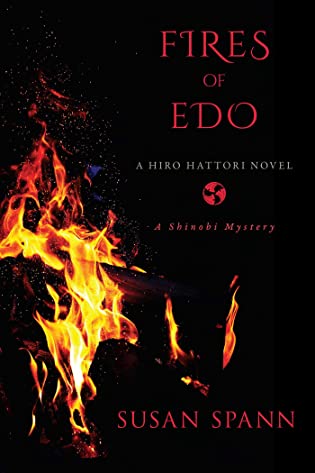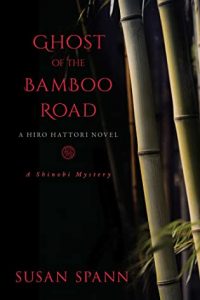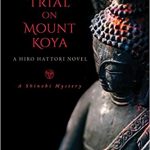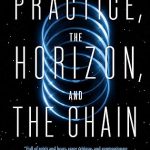 Fires of Edo (Shinobi Mystery #8) by Susan Spann
Fires of Edo (Shinobi Mystery #8) by Susan Spann Format: eARC
Source: supplied by publisher via Edelweiss
Formats available: paperback, ebook
Genres: historical fiction, historical mystery, mystery
Series: Shinobi Mystery #8
Pages: 230
Published by Seventh Street Books on February 15, 2022
Purchasing Info: Author's Website, Publisher's Website, Amazon, Barnes & Noble, Kobo, Bookshop.org
Goodreads
Edo, February 1566: when a samurai’s corpse is discovered in the ruins of a burned-out bookshop, master ninja Hiro Hattori and Jesuit Father Mateo must determine whether the shopkeeper and his young apprentice are innocent victims or assassins in disguise. The investigation quickly reveals dangerous ties to Hiro’s past, which threaten not only Edo’s fledgling booksellers’ guild, but the very survival of Hiro’s ninja clan. With an arsonist on the loose, and a murderer stalking the narrow streets, Hiro and Father Mateo must save the guild—and themselves—from a conflagration that could destroy them all.
My Review:
 The entire Shinobi Mystery series, starting with Claws of the Cat, takes place in feudal Japan beginning in 1564, at a time when few foreigners were permitted in the country. (For reference, 1564 was early in Elizabeth I’s reign in England, William Shakespeare was born and St. Augustine, the oldest continuously-inhabited European-established settlement in what is now the continuous U.S., would not be established until the following year.) More importantly, 1564 and the years following in Japan were a time of political upheaval, as the events that push the series forward frequently show.
The entire Shinobi Mystery series, starting with Claws of the Cat, takes place in feudal Japan beginning in 1564, at a time when few foreigners were permitted in the country. (For reference, 1564 was early in Elizabeth I’s reign in England, William Shakespeare was born and St. Augustine, the oldest continuously-inhabited European-established settlement in what is now the continuous U.S., would not be established until the following year.) More importantly, 1564 and the years following in Japan were a time of political upheaval, as the events that push the series forward frequently show.
This is particularly the case in Fires of Edo. Hattori Hiro and the man he has been hired to protect, Father Mateo Ávila of Portugal, have stopped at Edo (the future Tokyo) on their long journey from Kyoto to a location that is still under debate between the two of them.
Hiro is supposed to take Father Mateo to the safety of the Portuguese colony at Yokoseura – where Hiro can keep the man who has become his friend over the course of their association – safe. But Father Mateo does not have any desire to be “safe” and confined among his fellow countrymen. He wants to continue to explore Japan – because once he enters that sanctuary he may not be able to get back out.
But that safety starts looking pretty attractive during their entirely too eventful sojourn in Edo.
As they have made their rather meandering way across the country, Hiro has been carrying out a self-appointed mission for his ryu – the clan of shinobi (read as ninja) that raised him and trained him. The identities of his fellow agents have been compromised, revealed to Oda Nobunaga and the forces that support Nobunaga’s rise to control the shogunate (which eventually happened in 1568).
Hiro and Father Mateo have faced plenty of adventures along their journey, some begun by Father Mateo’s inability to keep from poking his nose in places it doesn’t belong. Others as a result of either Hiro’s mission or his hidden identity as a shinobi or both.
They’re both responsible for their landing in the mess they uncover in Edo. Father Mateo can’t bear to see a man who may be innocent condemned to death without an investigation for a crime that even at the briefest glance appears to have not been his fault. Something reeks about this whole case – and it’s not just the camphor that seems to have started a whole bunch of coincidental fires that are too many and too much alike to be truly coincidental.
Meanwhile, one of the men that Hiro has come to warn is the investigator for the crimes. He is also a man whom Hiro has never trusted after their rivalry in childhood and young adulthood. Hiro is certain something is rotten in Edo and in this investigation – if only because his old enemy is in it up his neck.
Or possibly up to Hiro’s.
Escape Rating B: When Hiro and Father Mateo arrive at their comfortable inn in Edo, at first it seems as if they will finally get a bit of a rest. Or at least not have to face the metaphorical ghosts they did in the previous book in this series, Ghost of the Bamboo Road.
This time around, the ghost that Hiro has to face is entirely too real. The man that Hiro has come to Edo to warn, Daisuke, is a ghost of Hiro’s past. When they were both young and being trained in the arts of the shinobi, Daisuki locked Hiro in a small space with a corpse. They were young, they were being entirely too foolish, and the incident left Hiro with no fear of corpses or ghosts whatsoever – unlike the norm for his time and culture.
But it did leave Hiro with a profound distrust of Daisuke – a distrust that continues into adulthood. Father Mateo believes that Hiro should forgive the other man, not for Daisuke’s sake but for his own.
But Hiro can’t shake his distrust – a distrust that grows into suspicion as the three men are caught up in a series of crimes that seem to be intended to either expose the shinobi in Edo or cover up their activities – at the expense of an innocent man’s life if necessary.
That the crimes that this mystery is wrapped around all involve printing and bookbinding shops made the story a bit of a treat for this librarian. On my other hand, the character of the intrusive, ineffective, conclusion-jumping junior police officer grated on my last nerve.
 Of course, he’s supposed to. That he managed to fail upward at the end was a bit more annoying – even if all too realistic – than I really wanted to see. (Honestly, I wanted him to turn out to be the criminal. He was so obviously suspicious that it didn’t seem possible but no one stuck out quite the way he did.)
Of course, he’s supposed to. That he managed to fail upward at the end was a bit more annoying – even if all too realistic – than I really wanted to see. (Honestly, I wanted him to turn out to be the criminal. He was so obviously suspicious that it didn’t seem possible but no one stuck out quite the way he did.)
The crimes that are covered and uncovered seemed as if they were tangential to the real business – right up until the end. So I was certainly fooled – but not quite as enthralled as I was with Ghost of the Bamboo Road.
But I adore this series, and can’t wait to see where Hiro and Father Mateo’s wandering journey takes them next!

















